An excerpt from Yesterday When I Was Young, a 2025 memoir by Suzanne Lynch (née Donaldson), reprinted with permission.
--
After five years as The Chicks, Judy and I decided it was time to “spread our wings” and go our separate ways career-wise. We had experienced an incredible five years together recording, appearing on television, voicing or appearing in advertisements, and performing so many shows around New Zealand that we lost track of just how many we did and where we did them.
Being that little bit older than me, Judy was out dating and pursuing other interests, and we both felt that things had come to a natural end. She was also frustrated by the fact that we never qualified for any awards because we weren’t classified as a group or as soloists, and there were no awards given to duos.
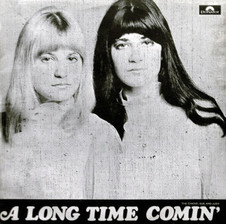
The Chicks' fourth and final album, A Long Time Comin' (Polydor, 1970), with cover photography by a young Roger Donaldson.
The Chicks’ last-ever album A Long Time Comin’ was recorded at HMV Studios in Wellington and produced by Rob Robinson. Judy and I had a small say in the track listing and were allowed to choose a solo each. We both picked Dusty Springfield covers for our solos. Mine was ‘Goin’ Back’ and Judy’s was ‘The Look of Love’. I loved the cover shot which was taken through sacking and tinted with sepia. The photo was by a 25-year-old Kiwi photographer by the name of Roger Donaldson (no relation to our family) who later became a well-known film director in the US. I was usually very ho-hum about our artwork because we never had any say in it, but I was delighted with the way things turned out on this record.
Ray Columbus [our manager] found Judy a residency at a hotel in Hong Kong for a few weeks before she headed to Australia to live, while I remained in New Zealand.
We moved separately into the 1970s, with The Chicks staying behind as part of the 1960s.
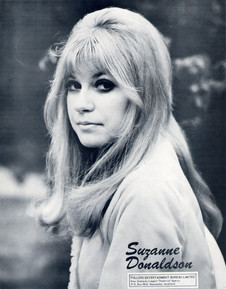
Fullers Entertainment publicity card for Suzanne Donaldson. - Judy Donaldson collection
I can vividly remember my first solo stage appearance without my other half there beside me. I was beyond nervous. I had never sung on stage by myself, as myself. Judy had always been there, standing next to me, her voice in my ear. Ray literally had to push me onto the stage. It took a little while to get used to not singing harmonies with somebody, or matching their dance moves, but one thing did stay the same: my love of singing with a band.
My talent card for my agents, Fullers Entertainment Bureau, had me as “Suzanne Donaldson” even though Ray had a thing about artists being known by their first names only. In June 1970, I had the honour of being part of the opening performances for Motown recording stars The Four Tops. There were three acts before them: “New Zealand’s Mr Soul” (as he was billed) Sonny Day, The Dallas Four, and then me. I was promoted in the souvenir programme as “Everyone’s favourite, vivacious, talented … Suzanne Donaldson.”
It was lovely to be described that way, obviously, but from there on out I just became “Suzanne”.
One day, out of the blue, Ray rang me to say I had been offered a gig as a resident soloist on a new Kevan Moore-produced TV pop series, Happen Inn. The show was replacing C’mon and would feature guest artists each week.
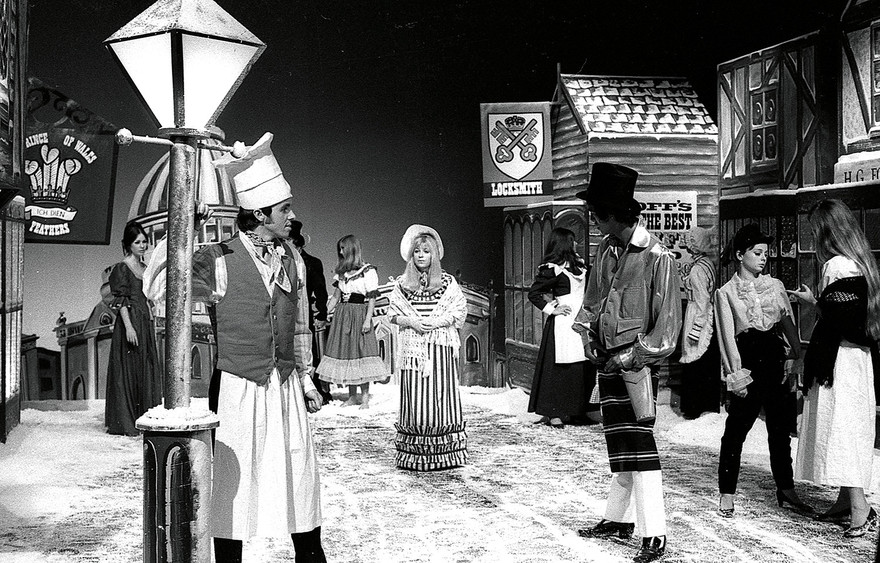
Great expectations: Suzanne on an elaborate set built for NZBC TV's Happen Inn programme. Photo by Bruce King.
I was very excited, knowing this would be a great opportunity for me. Another bonus was that Craig Scott was headlining alongside me. I had met him and one of his bands, The Revival, in Christchurch and knew him to be a great singer and a really nice guy, The compere for Happen Inn would again be Peter Sinclair, and the team of dancers included my friends from C’mon, Chrissy Blue and Grant Whiteman, along with Christeen Shaw, Trish Hodgson and Vicky Haughton. Another great surprise was that Ray Woolf, who I had been so impressed with during my first-ever appearance on television, was also appearing!
Kevan took Happen Inn in an entirely different direction from C’mon, making it more of a “variety show” where we all dressed up as different characters, depending on what we were singing. While we still did solo spots, there were a lot more group performances and duets. The stage sets and the costumes were often very lavish, and I could go from being a Victorian lady one day to a cowgirl the next.
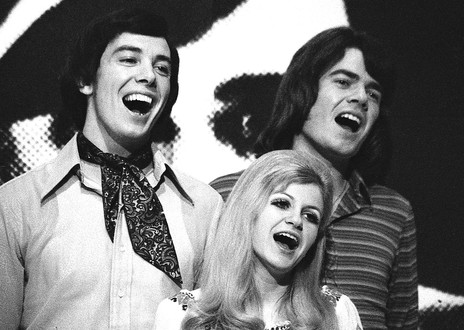
Happen Inn: Suzanne with Vaughan Lawrence and Craig Scott
An incident from Happen Inn that is etched on my memory involved Craig as well. To close each show, the resident cast and the guest artists would each perform a couple of lines from songs in that week’s top ten. Because the sequence of rehearsing and recording of Happen Inn was similar to that of C’mon, I was used to learning my words throughout the week, to be mimed as the show was filmed. The big difference from C’mon was that closing sequence.
There was one week when it all turned to custard! Both Craig and I had been away in different towns in the South Island performing our live shows, which left us no time to rehearse our “top ten of the week” lyrics. On the day of the show’s filming, we both realised that neither of us really knew the lyrics for the songs we were about to mime to in the top ten. Not to worry, we came up with what we thought was a “foolproof” plan. In rehearsals we checked which camera was on us for our close-ups and just learned those lines. At dress rehearsal our lip sync was perfect. From the lofty heights of the control room, Kevan could obviously see that we’d only learned the lines for our close-ups and were bluffing everything else. When the show went live-to-air, everything was going great until right up to the top ten hits final segment. Kevan had changed all the camera close-up shots, leaving both Craig and I exposed, looking like goldfish in a bowl desperately trying to form the right words. It was sooooo embarrassing!! Our cunning plan had failed dismally.
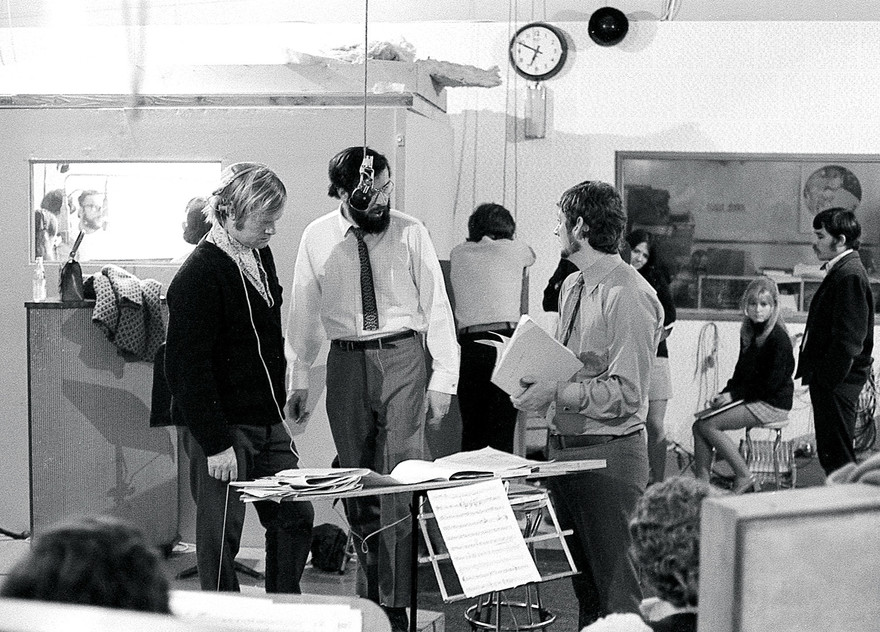
Happen Inn recording session at Mascot Studios, Auckland, September 1970. On the right-hand side, Suzanne looks towards the camera at her future husband, guitarist Bruce Lynch. In the centre are trombonist Neil McGough, musical director Bernie Allen, and vocal arranger Wayne Senior. The photo is by drummer, Bruce King.
When the recording had finished, we were still sitting in our final positions when we heard the dreaded “clunk, clunk, clunk” and could smell the pipe smoke as Kevan descended the metal stairs from the control room. Before Kevan could say anything, I leapt up and said, “Don’t you fire me, because I quit!” There was deathly silence from the cast and production crew.
I ran out of the studio, back to the makeup room and burst into tears. As I was packing up to leave, I could again smell Kevan’s pipe tobacco … I was preparing for the worst. He poked his head around the door and said, “See you on Monday, Suzanne.” I sheepishly smiled and said, “Yes, okay.” The incident was never mentioned again, but I bet Kevan had a few good laughs over it all. For me, it was a lesson well learned – lines must be learned properly.
I leapt up and said, “Don’t you fire me, because I quit!”
I must talk about a wonderful record producer, Peter Dawkins, who I first met when I was still in The Chicks. He came to one of our Wellington shows with Alan Galbraith, his friend, flatmate and co-worker at His Master’s Voice recording studio. We were in the middle of our season at the Beefeater Arms. The four of us became good friends. We often went to their flat to listen to music and discuss musical ideas. (Alan would later produce the first Space Waltz single, ‘Out On The Street’ and a host of other Kiwi acts through the 70s.)
When I went solo, I commented to Polydor that I would love to record in Wellington at the HMV recording studios in Wakefield Street, with Peter Dawkins, who had produced Shane’s debut album Rainy Day Man. Even though I had foolishly told Shane I didn’t think ‘Saint Paul’ was very “commercial” when he played it to me earlier that year, I had loved the four-track production on the single, and knew the studio had an amazing sound engineer. HMV had, through its reputation of turning out hit after hit, become THE studio in which to record in those days.
My wish was granted. Peter was hired, and, with his help, I was allowed to choose all the songs I wanted to record. Peter and I had spent many hours discussing the kind of music we both liked. We were on the same page and he totally understood what I was after in the studio. I really felt for the first time I could be me, and so I covered songs by Joni Mitchell, The Beatles and Leonard Cohen.
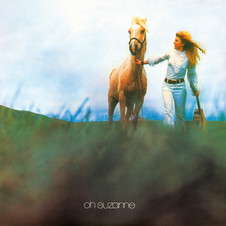
Suzanne - Oh Suzanne (Philips, 1971). "My two great loves combined."
Having recorded ‘Stand by Your Man’ for the album, the general manager of Philips Records, and album co-ordinator, John McCready, thought I should now cover Tammy Wynette’s ‘D-I-V-O-R-C-E’, too, but I refused. I was single and only 20 at the time! It didn’t make sense for me to sing that song. He retaliated by telling me I was no more important to him than a can of baked beans was to Mr Wattie! Peter came to my defence, but that comment was a dose of the cruel reality that only the music business can provide.
Fortunately, the album, Oh Suzanne, released in 1971, turned out to be my favourite of all time. I think I sang the best I ever have, as I was so comfortable. It was my kind of music, with one of my really good friends in charge, and an expert engineer in Peter Hitchcock. Bruno Lawrence played drums, and Dale Wrightson was in charge of the art direction. I was so happy with the mixes, the songs, the sounds ... everything. Even the album cover – a shot of me leading a horse through a field. My two great loves combined: music and animals. The photographer, Ian Munroe, captured the essence of the album with that shot, so the whole thing was a wonderful experience.
--
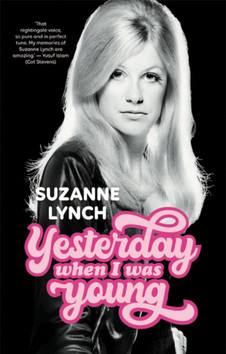
An excerpt from Yesterday When I Was Young, a memoir by Suzanne Lynch (née Donaldson) with Karyn Hay (David Bateman Ltd, 2025), published with permission.